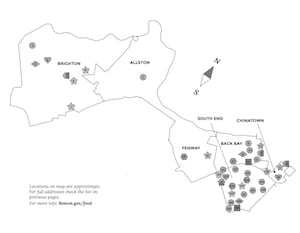Who is a member?
Our members are the local governments of Massachusetts and their elected and appointed leadership.

A map showing various food resources in Boston neighborhoods includes a list with detailed information that corresponds with each marker.
Boston has created food resource maps that identify free, low-cost and emergency food outlets in each of the city’s neighborhoods.
The graphical maps provide an outline of each neighborhood, with numbers and symbols to mark food pantries, meal sites, senior dining sites, locations that offer application assistance for the Supplemental Nutrition Assistance Program (SNAP), and farmers markets that accept SNAP and Healthy Incentives Program (HIP) benefits.
The numbers on the maps correspond with a comprehensive list of addresses, contact information and operation schedules where applicable, such as for farmers markets.
Maps are distributed through community health centers, community centers, senior centers and other locations throughout each neighborhood. They are also available for download from the city website.
The maps are available in English, Spanish, Chinese (Traditional and Simplified), Haitian Creole, Russian and Vietnamese.
Elizabeth Miller, a food security fellow with the Mayor’s Office of Food Access, said the idea for the maps began with staff at community health centers, who alerted the mayor’s office that people were seeking food assistance from the centers and needed immediate referrals.
“We were targeting people kind of at a chronic emergency stage, consistently needing more food, or [those who] recently lost their job and suddenly don’t have enough money to buy food,” Miller said.
Because of that, the Mayor’s Office of Food Access worked with the city’s Department of Innovation and Technology and its Public Health Commission to identify food options that are either low-cost or free, with the exception of farmers markets, which were included only if they accepted SNAP and HIP benefits.
The city opted for paper maps because many lower-income households and homeless individuals lack access to a computer.
Miller said the maps also address, to an extent, the problem of “food deserts,” where a neighborhood lacks access to fresh, affordable and nutritious food as opposed to cheaper and less healthful processed foods.
“A lot of food pantries have limited fresh produce available,” Miller noted. “The [map’s] resources are all combined to support the needs of individuals living in areas where [healthy food choices] are limited.”